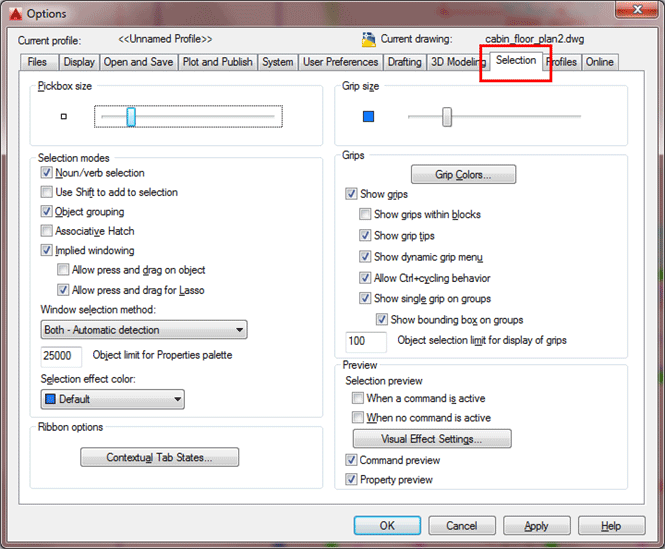Selecting Objects in AutoCAD
- LESSON 1-1X-Y CO-ORDINATE SYSTEM, INPUTTING POINTS, AUTOCAD SCREEN, BASIC TERMINOLOGY
- LESSON 1-2ASSIGNMENT 1 INTRO TO DRAWING / MODIFYING COMMANDS
- LESSON 1-3MORE MODIFYING COMMANDS / OBJECT SNAPS (TRIM EXTEND OFFSET)
- LESSON 1-4ASSIGNMENT 3 ACCURATE INPUT
- LESSON 1-5SELECTION SETS
- LESSON 1-6ASSIGNMENT 4 MODIFYING COMMANDS (MOVE COPY STRETCH MIRROR)
- LESSON 1-7ASSIGNMENT 5 MODIFYING COMMANDS (ROTATE FILLET CHAMFER ARRAY)
- LESSON 1-8ASSIGNMENT 6 (LAYERS DIMENSIONS TEXT SCALE)
- LESSON 1-9DIRECT DISTANCE ENTRY AND OBJECT TRACKING
- LESSON 1-10CHANGING THE PROPERTIES OF OBJECTS
- LESSON 1-11ZOOMING AND PANNING AROUND A DRAWING
- LESSON 1-12ORTHOGRAPHIC PROJECTION
- LESSON 1-13SECTION VIEWS
- QUIZ FOR LEVEL 1 - 46 QUESTIONS
Topics covered in this Lesson:
Creating Selection Sets | Changing Your Selection Options
By now you have probably seen a colored rectangle appear on your screen when you left-click and the move the crosshairs around. You'll learn all about these in this lesson. AutoCAD uses what's called a selection set to allow you to group objects together and then modify them. For example, if you want to erase several lines, you could press E <ENTER>, pick on the line, press <ENTER> again and repeat until you're done. Another way would be to press E <ENTER>, and then pick the lines one by one until they are all selected, and press <ENTER>. By selecting a group of objects, you have created a selection set. Whenever you want to modify an object, and are asked by AutoCAD to "select objects" you can create a selection set and then apply the command.
REMEMBER TO PRESS ENTER WHEN YOU ARE FINISHED SELECTING THE OBJECTS
There are several ways to create a selection set. The most common way is to use a window.
There are two very different types of windows you can use.
One is a 'crossing selection' and the other is a 'window selection' (or 'box'). If you create the selection from right to left, you make a crossing window. This means that any object that crosses the border or is surrounded by the window is added to the selection set. This is shown as a green rectangle with a dotted outline on the screen. If you create the window from left to right, you create a box. Using this method you'll add only the items that are completely within the box. This is shown as a blue box on the screen. The difference is very important.
| Direction | Called | Display | Effect |
|---|---|---|---|
| RIGHT TO LEFT | CROSSING SELECTION | 
|
SELECTS ANY OBJECT THAT EITHER CROSSES THE BOUNDARY OR IS INSIDE IT |
| LEFT TO RIGHT | WINDOW SELCTION | 
|
SELECTS ON OBJECTS THAT ARE COMPLETELY WITHIN THE BOX |
NOTE: New in AutoCAD 2015: By default, the crossing selection is a 'Lasso' in place of the 'window' that many users are not used to seeing. This can be changed in the Options Dialog under Selection > "Allow Press and Drag for Lasso"
There are other ways to select objects and here a few of the more common ways. These can also be used in combination.
REMOVE - by typing R when asked to select objects, AutoCAD will select change to allow you to Remove objects from the selection set. You can also remove individual objects by pressing the Shift Key when selecting (known as a 'shift-select').
LAST - by typing L when asked to select objects, AutoCAD will select the last object that you created. This is handy if you create something and want to move or modify it right away.
PREVIOUS - by typing P when asked to select objects, AutoCAD will select the previous selection set. This is used if you select a few objects, modify them and then want to modify them again.
FENCE - by typing F when asked to select objects, AutoCAD allows you to draw a series of lines (called a fence) to select objects. This is convenient if you want to select a group of lines to be trimmed to a single cutting edge.
CROSSING POLYGON - typing CP when you are selecting objects give the ability to create a crossing polygon for object selection. This is similar to a crossing box (drawn like a Fence), but you can pick points on the screen to create a polygon. By default, this is a crossing polygon, therefore any objects that cross the polygon will be added to the selection set.
CROSSING WINDOW - typing WP (window polygon) when you are selecting objects give the ability to create a crossing window for object selection. This is similar to a crossing box, but you can pick points on the screen to create a polygon. This is a crossing window, therefore any objects that are completely within the polygon will be added to the selection set. Newer versions of AutoCAD allow you to use your cursor to create a crossing window without typing in the 'CW'.
CYCLING - When are ready to select objects, hold down the Shift key on your keyboard and then press the Space Bar when your mouse is on top of overlapping objects. Repeatedly press the Space Bar until the one object you want to modify is highlighted. Then pick with the mouse. This is a good approach if you have many objects in a small area.
To deselect everything you have selected, you just press the escape key on your keyboard or
right-click and choose "Deselect All" from the menu.
TIP: Zoom in when
selecting in tight spaces. Make sure you are 100% sure you are selecting the correct object.
Imagine the difference
of offsetting an interior wall instead of the exterior wall - the resulting object would be off
by over 6 inches! Get used to zooming in, then zooming out quickly (the mouse wheel is great for
this).
You need to quickly select objects in AutoCAD to be a good CAD operator.
For practice, open one of your previous drawings and try selecting objects using all of the methods described above. Notice that as you move your cursor over an object the object will highlight.
Video: Selecting Objects - Part 1
Video: Selecting Objects - Part 2
Changing your selection options
Many people are
happy with the default AutoCAD settings. Sometimes you might want to change your settings for
things like your grip or pickbox size.
This is totally personal and it's your call. I'll show how to change these, but remember where
the settings are in case you want to change them back.
Type in OP for Options and look for the Selection tab. You'll see a dialog box that looks like the one below.

As you can see, you can customize a few things. Think about having a drawing that has a lot of blue lines in it. If you want, you can change your grip color so that they are clearer. Some people like a larger pickbox size, but I prefer a smaller box that is more precise. Another option that is used a lot is "Enable grips within blocks" - you'll learn about grips and blocks in later lessons.
You Scored:

Fun fact: Greg Lutz, who had been working full time on AutoCAD-86, was the first employee at a salary of $1,000 per month starting in January, 1983. The company was still not sure that the business would be successful, so the agreement with Lutz was initially for just four months.
Please support
MyCADsite.com
Give a donation!
Donate

- To cover this months server costs
- Exceeding amounts will go to creating new content
- Even a penny will help
Did you like the lesson? ❤️
